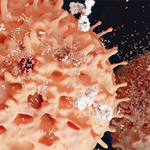“We also find that high salt intake in preliminary analysis, in interaction with smoking, could be of importance in the development of rheumatoid arthritis,” she said.
Complex Model of RA Progression Starts in the Lung
Anca Catrina, MD, PhD, professor of rheumatology at the Karolinska Institute in Stockholm, reviewing work at her center and elsewhere, proposed a multifaceted model on how rheumatoid arthritis begins and progresses.
She said it’s “a model of rheumatoid arthritis onset at extraarticular sites that start with the genes and environment, leading to changes in lungs, gums, gut, lymph nodes, [and] generating humoral immunity, but also local changes in bone turnover. And then, possibly, the need for a second hit,” or trigger, for the disease to spread to the joint.
Work at her center has reinforced the notion that the lung might be central to the start of RA.
One study, consisting of 105 RA patients and 43 controls, involved high-resolution computed tomography (HRCT) and a test of pulmonary function at baseline, with the same assessment at six months.
There were more parenchymal changes on HRCT in the ACPA-positive RA patients compared to both the controls and the ACPA-negative RA patients. There was also much more lymphocyte infiltration in the lungs of the ACPA-positive patients.
Further studies have found that certain citrullinated targets can be found in both the lungs and the joints in RA patients, making a link even more likely.
Combined with other recent findings on ACPA promoting bone destruction and links with periodontitis, the search for RA’s origins is starting to paint a picture that includes many levels or steps, although those levels might not always remain distinct from one another, Dr. Catrina said.
Asked whether the activity in the joints and lungs might develop in parallel, she agreed that might be the case. “I am not saying that what I am saying is the only truth—I am saying that there are different truths” from which the ultimate model has to be derived, she said. “I think the lungs may play a different role in some different stages of the disease. And the true hypothesis—one, that the lung will initiate the process, and the other one, that the lung is just a part and bystander in the whole process—they’re not mutually exclusive.”
Patient Characteristics for Treatment Selection
In another presentation, D.M. Gerlag, MD, PhD, of the Academic Medical Center at the University of Amsterdam, discussed work aimed at assessing who should be candidates for preventive treatment and exploring the use of rituximab to help stave off onset of RA.


